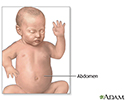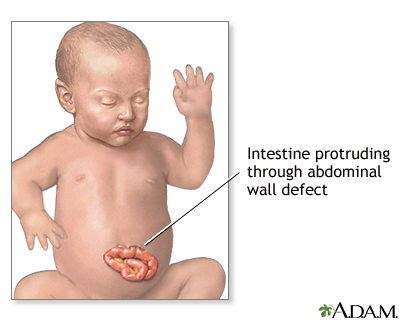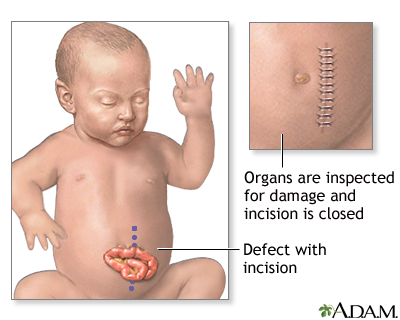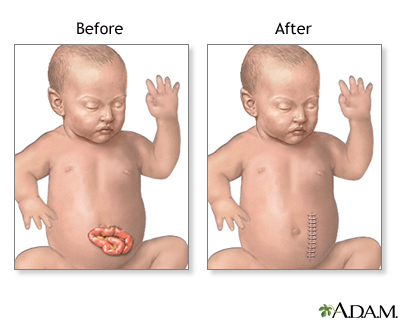Gastroschisis repair
Abdominal wall defect repair
Gastroschisis repair is surgery to correct a birth defect that causes an opening in the skin and muscles covering the belly (abdominal wall). The opening allows the intestines and sometimes other organs to bulge outside the belly.
Gastroschisis
Gastroschisis is a birth defect in which an infant's intestines are outside of the body because of a hole in the abdominal wall.

Description
The goal of surgery is to place the organs back into the baby's belly and fix the defect, if possible.
After your baby is born, the surgeon will wait until your baby is stable enough to have surgery. This may take 7 to 10 days. During this time, a plastic pouch called a silo will be used to return most of your baby's intestines and other organs into the belly.
The surgery is done in the following way:
-
Your baby receives
general anesthesia
. This is medicine that allows your baby to sleep and be pain-free during the operation.
General anesthesia
General anesthesia is treatment with certain medicines that puts you into a deep sleep so you do not feel pain during surgery. After you receive the...
Read Article Now Book Mark Article - The surgeon examines your baby's intestine (bowel) closely for signs of damage or other birth defects. Unhealthy parts are removed. The healthy edges will be stitched together.
- The organs that are outside the belly are placed back into the belly.
- The opening in the wall of the belly is repaired, if possible.
More surgery may be needed at a later time to repair the muscles in your baby's belly.
Why the Procedure Is Performed
Gastroschisis is a life-threatening condition. It needs to be treated soon after birth so that the baby's organs can develop and be protected in the belly.
Risks
Risks for anesthesia and surgery in general are:
- Allergic reactions to medicines
- Breathing problems
- Bleeding
- Infection
Risks for gastroschisis repair are:
- Breathing problems if the baby's belly area (abdominal space) is smaller than normal. The baby may need a breathing tube and breathing machine for a few days or weeks after surgery.
- Inflammation of tissues that line the wall of the abdomen and cover the abdominal organs
- Organ injury
- Problems with digestion and absorbing nutrients from food, if a baby has a lot of damage to the small bowel
- Temporary paralysis (muscles stop moving) of the small bowel
Before the Procedure
Gastroschisis is usually seen on ultrasound before the baby is born. The ultrasound may show loops of bowel freely floating outside the baby's belly.
After gastroschisis is found, your baby will be followed very closely to make sure he or she is growing.
Your baby should be delivered at a hospital that has a neonatal intensive care unit (NICU) and a pediatric surgeon. A NICU is set up to handle emergencies that occur at birth. A pediatric surgeon has special training in surgery for babies and children. Most babies who have gastroschisis are delivered by cesarean section.
Right after birth:
- Organs that are outside your baby's body will be covered with a warm, moist, sterile dressing or a sterile plastic bag.
- A nasogastric (NG) tube will be inserted through your baby's nose or mouth into the stomach to keep the stomach empty. This prevents the baby from choking and breathing stomach contents into the lungs.
After the Procedure
After surgery, your baby will receive care in the NICU. The baby will be placed in a special bed called an isolette. This bed has an incubator to keep your baby warm.
Your baby may need to be on a breathing machine until organ swelling has decreased and the size of the belly area has increased.
Other treatments your baby will probably need after surgery are:
- A nasogastric (NG) tube placed through the nose to drain the stomach and keep it empty.
- Antibiotics
- Fluids and nutrients given through a vein
- Oxygen
- Pain medicines
Feedings are started through the NG tube as soon as your baby's bowel starts functioning after surgery. Feedings by mouth will start very slowly. Your baby may eat slowly and may need feeding therapy, lots of encouragement, and time to recover after a feeding.
The average stay in the hospital is a few weeks up to a few months. You may be able to take your baby home once he or she is taking all foods by mouth and gaining weight.
Outlook (Prognosis)
After you go home, your child may develop a blockage in the intestines ( bowel obstruction ) due to a kink or scar in the intestines. The doctor can tell you how this will be treated.
Bowel obstruction
Intestinal obstruction is a partial or complete blockage of the bowel. The contents of the intestine cannot pass through it.

Most of the time, gastroschisis can be corrected with one or two surgeries. How well your baby does will depend on how much damage there was to the intestine.
After recovering from surgery, most children with gastroschisis do very well and live normal lives. Most babies who are born with gastroschisis do not have any other birth defects.
References
Islam S. Advances in surgery for abdominal wall defects: Gastroschisis and omphalocele. Clin Perinatol . 2012;39:375-86. PMID: 22682386 www.ncbi.nlm.nih.gov/pubmed/22682386 .
Klein MD. Congenital defects of the abdominal wall. In: Coran AG, ed. Pediatric Surgery . 7th ed. Philadelphia, PA: Elsevier Saunders; 2012;chap 75.
Review Date: 3/13/2015
Reviewed By: Debra G. Wechter, MD, FACS, general surgery practice specializing in breast cancer, Virginia Mason Medical Center, Seattle, WA. Also reviewed by David Zieve, MD, MHA, Isla Ogilvie, PhD, and the A.D.A.M. Editorial team.





